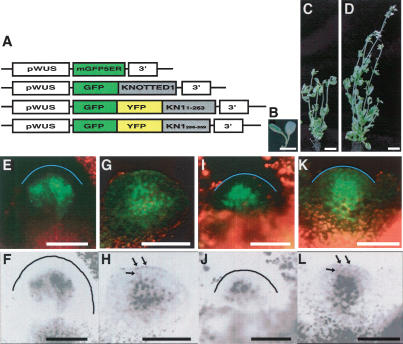Figure 4.
The KN1 trafficking signal domain functions in the meristem, and L3-specific expression of KN1 is sufficient to complement shootmeristemless-11 (stm-11) mutants. (A) GFP fusion constructs used for protein trafficking assays in the SAM. Constructs include the L3-specific WUS promoter (pWUS), mGFP5-ER, GFP, or GFP∼YFP fusions to KN1 or to KN1 deletions constructs, and the nopaline synthase terminator (nos 3′) or the KN1 3′UTR (3′). The third construct contains KN11–263 and the fourth contains KN1256–359. (B) stm-11 mutants show fused cotyledons and no true leaves. pWUS::KN1 expression (C) rescued 14 plants out of 46 stm-11 T1 homozygotes, and pWUS::GFP∼KN1 expression (D) rescued four plants out of 10 stm-11 T1 homozygotes. Thus pWUS-driven KN1 or GFP∼KN1 expression can rescue the function of STM, which is normally expressed in all three layers of the SAM (Long et al. 1996). (E–L) Confocal microscope images of meristems expressing these GFP constructs; mGFP5-ER is restricted to the L3 (E,F). GFP∼KN11–359 shows movement into L2 and L1 cells, seen as green nuclear fluorescence (G) or in grayscale with labeled nuclei indicated by arrows (H). GFP∼YFP∼KN11–263 is restricted to the L3 (I,J), and GFP∼YFP∼KN1256–359 shows movement into L2 and L1 cells (K,L), indicating that the trafficking signal region identified in KN1256–359 also functions in the meristem. Note that in the inverted grayscale images, the fluorescence of nuclei in the L1 and L2 layers is more pronounced. Labeled nuclei in the L1 and L2 layers are indicated by arrows in H,L. The outer surface of the L1 is marked by a blue line in E,I,K and by a black line in F,J. Bars: E–L, 50 μm.

